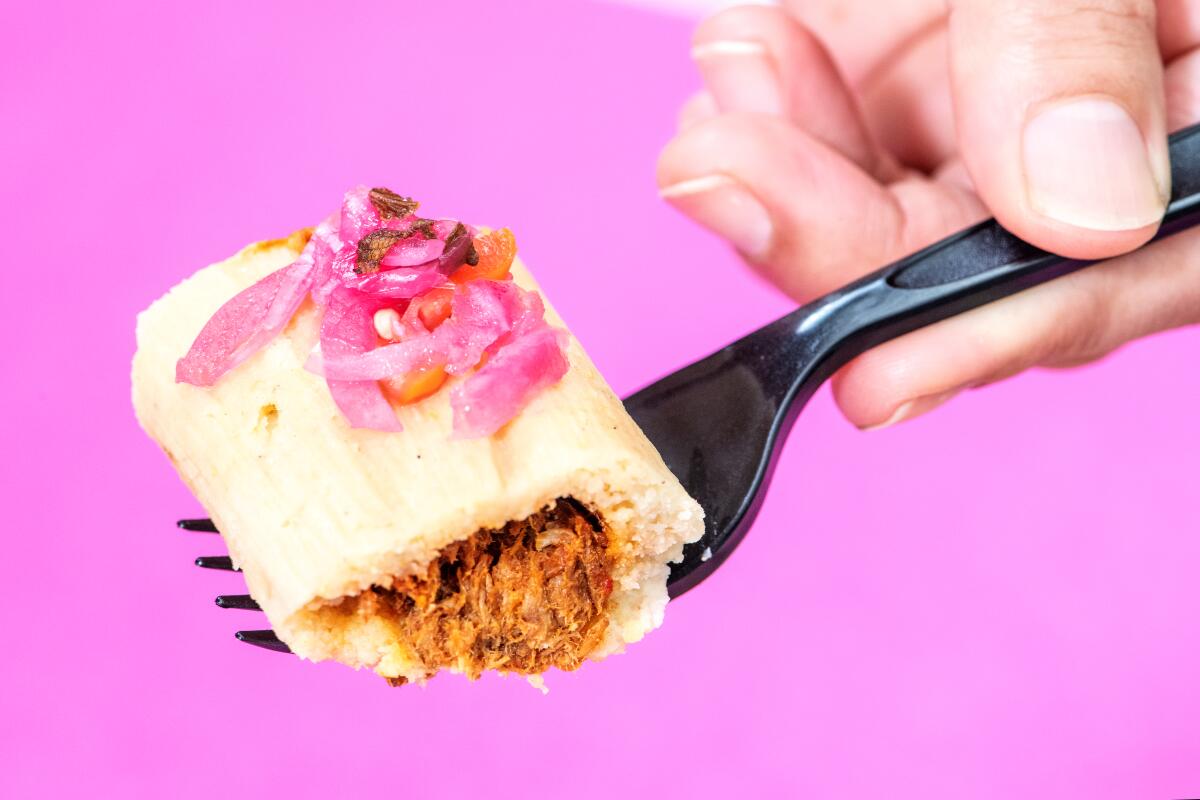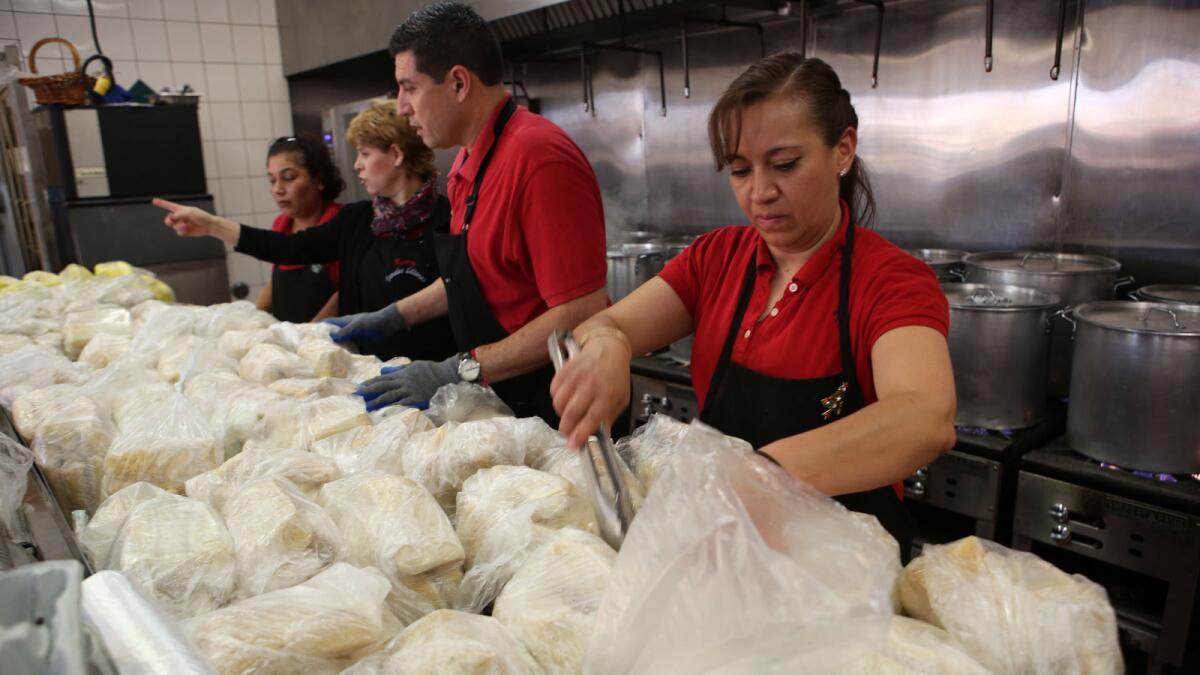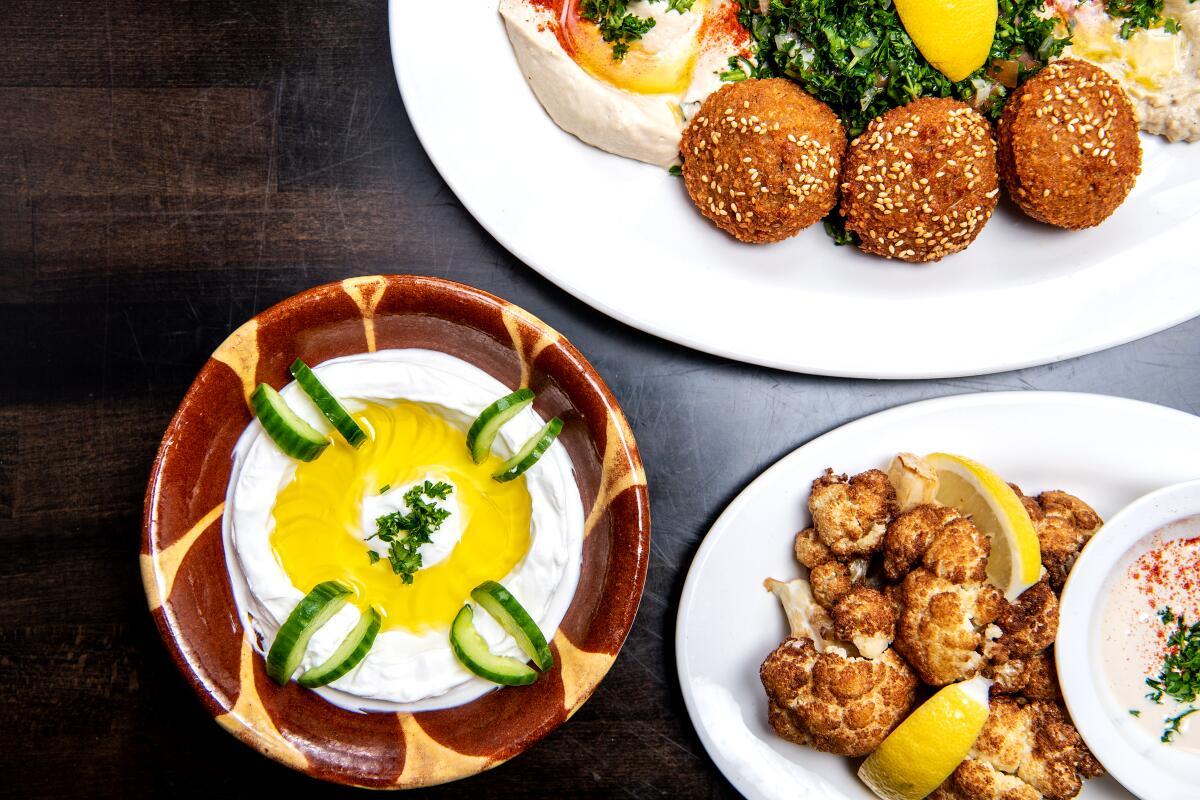Newsletter: Who should be making (and selling) tamales?

- Share via
December is tamale-making season in Los Angeles, the time of year when I inevitably find myself elbow-deep in a tub of masa.
In my family, the tamale prodigies include my husband, who makes green chile pork tamales in the wantonly spicy northern New Mexico tradition, and my mother, who can transform bubbling vats of guisados and hand-blended masa into pyramids of neatly stacked tamales in half a day or less.
I’ve been thinking a lot about tamales this week. (One of my favorite foods, they are never far from my mind.) In this week’s review, I considered the machine-made tamales at Artesano Tamaleria, a new café in downtown Los Angeles.
And a few days ago, I received an email from a family friend asking for the kind of tamale-related advice that has nothing to do with masa recipe hacks.
She recently brought homemade tamales to her office to share with coworkers. One colleague offered to pay to her to make a batch for them; another voiced concern that she would be taking business away from Latino tamale-makers if she did.
Her question to me: Is she — a white woman who married into a Mexican family — appropriating her husband’s culture by selling tamales?
Her question reflects a larger conversation happening in contemporary food and cooking culture: Who has the right to make and profit from certain foods, particularly those from cultures that have been historically disenfranchised and exploited in this country?

It’s a question I wrote about in 2017 after a burrito cart in Portland was charged with cultural appropriation. Earlier this year, in separate incidents, high-profile restaurateurs Gordon Ramsay and Andrew Zimmern reignited the debate.
The topic of cultural appropriation is both big and nuanced; every incident deserves thoughtful consideration.
But here’s what I told my friend: Tamale-making and vending has a long, fascinating history in this country. There’s a long tradition of African American tamale makers along the Mississippi Delta. In one of my favorite New Yorker stories of recent years, writer Kathryn Schulz illuminates the history of Afghan tamale makers in the American West.
Tamales were a popular commodity in early 20th century America, sold by immigrant men from around the world. (To read more about this history, pick up a copy of Gustavo Arellano’s rollicking book, “Taco USA”).
Tamales, one of the oldest and most highly adaptable foods on this continent, have long been sold by people from every background, from itinerant European immigrant hawkers on the streets of New York City to Mexican families selling them off wagons in turn-of-the-century Los Angeles. They continue to be a point of entry for street vendors and fledgling food entrepreneurs.
I like to buy from every type of vendor that crosses my path, because everyone’s tamales are different, and life is too short not to try them all.
The advice I gave to my friend: Fill yourself with appreciation and respect for the dish’s long history and the cultures that gave it to us. Then go forth and make tamales.
What are your thoughts? Email me at patricia.escarcega@latimes.com.

Ask the critics
I want a print copy of the 101 Best Restaurants in L.A. Where can I buy one?
— Lesley, Twitter
The print magazine version of the 101 Best Restaurants in L.A. is now available in the L.A. Times Store. You can purchase it here for $9.95. It features a bright new design from Martina Ibánez-Baldor and Steve Banks, with a cover illustration from Steve Wilson. I’m framing my copy.
Big news
The print L.A. Times Food section is moving to Sundays!
Starting Jan. 5, look for the Food section in your Sunday paper.
(Don’t subscribe? New year, new you, new Sunday tradition. You can get the Sunday paper with an unlimited digital subscription.)

Top stories
- My fellow critic Bill Addison reviews Mona’s Kitchen, a Lebanese restaurant in Tarzana (try the beef tongue sandwich!).
- Columnist Lucas Kwan Peterson offers an appreciation of Porto’s Bakery & Café founder Rosa Porto, who died last week.
- Also from Lucas: In this episode of “Off Menu,” Lucas goes to South L.A. to visit two black-owned businesses that specialize in chicken sausage.
- Contributor David Karp considers nothing less than the future of fruit; and flavor scientist Arielle Johnson tells how to (and how not to) eat a tree.
- Cooking columnist Ben Mims has a recipe for a French-style tart that celebrates his favorite fruit: aromatic winter quince.
- Holiday dinner party emergency? Cooking Editor Genevieve Ko has your back. Her Costco-inspired dinner menu can be ready in under four hours (really!).
More to Read
Eat your way across L.A.
Get our weekly Tasting Notes newsletter for reviews, news and more.
You may occasionally receive promotional content from the Los Angeles Times.










